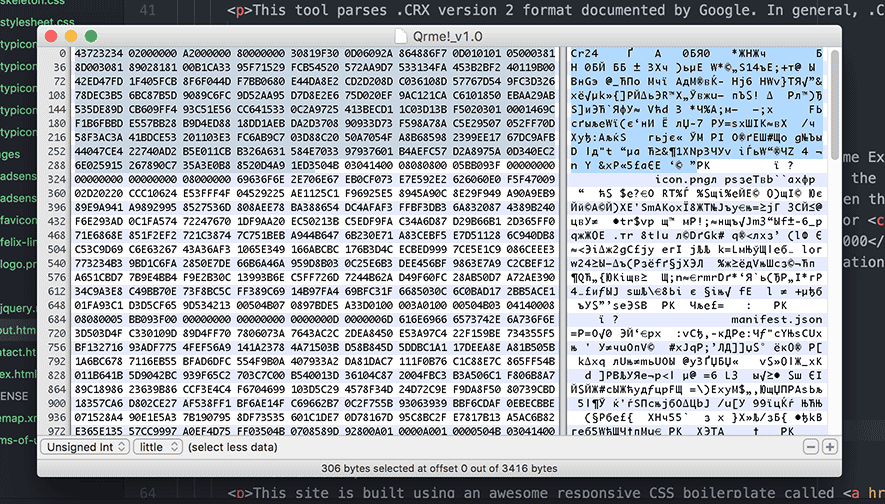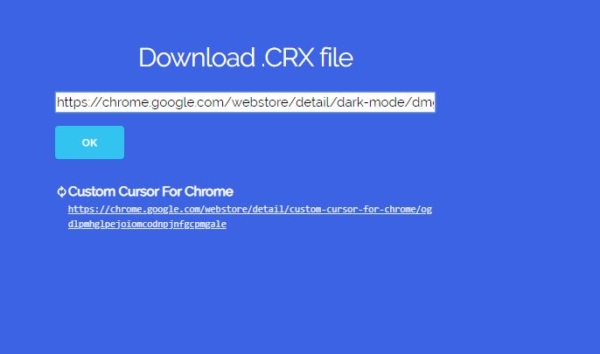
- CRX FILE EXTRACTOR HOW TO
- CRX FILE EXTRACTOR INSTALL
- CRX FILE EXTRACTOR WINDOWS
Drag-and-drop the CRX file from its location to Chrome’s Extensions menu. Open the ‘Extensions’ menu as explained in the previous sections. However, you can’t just click on these files and expect them to install. How to Import ExtensionsĪll of the aforementioned methods will download a CRX file. You can combine these two apps to quickly get all needed URLs and then get their CRX files. Just type in the extension ID or copy/paste the extension URL in the address bar and hit the ‘Download Extension’ button.Īnother useful extension is Export Links to All Extensions which exports all extension names and URLs to a single file. There are various third-party extensions and web apps whose only purpose is to help you export other extensions.įor example, Chrome Extension Downloader will download the CRX files directly from Chrome.
It’s important to use another browser (like Mozilla Firefox or Opera) because Google Chrome will try to install the extension automatically instead of downloading it. You should get the CRX file on your computer. A download window will pop up prompting you to complete the download.Once you get the ID, open any other browser besides Chrome and type this link in the address bar: ‘ ‘ remember to replace the ‘ ’ part with the proper ID and execute.

The ID is always the last part of the URL in the address bar. If you don’t, you can find the extension from the Chrome Web Store and copy the extension ID.
Using the method from the previous section, save the extension ID if you already have it on the computer. If packing extensions to a CRX file seems like a long and exhausting job, you can just save the extension URL somewhere and download it when you need it. Use a Special URL to Save and Download Extensions You can follow the same first six steps from the previous section, but the path to the extension folder is slightly different.įor MacOS users, the correct application folder is normally in ~/Library/Application Support.įor Linux users, the extension folder should be in the ~/.config folder. If you’re using MacOS or Linux, the process is slightly different. How to Find Extension Folder on MacOS or Linux 
You can share these CRX files, or store them on your drive. Now, the extension folder should have a CRX file too.įor each extension that you want to export, you can use the same method. Leave the Private key file section blank.
When the new window appears, select Browse, choose the folder that you’ve moved to the desktop and click OK. Now, go back to the Extensions menu and click the Pack extension button on the top-left corner of the menu.  Locate the folder that has the same ID and copy it to your Desktop. “ C:\Users\\AppData\Local\Google\Chrome\User Data\Default\Extensions“ Now, hold Win Key + E to open Windows Explorer and go to the following path:. Remember the ID that appears under the extension that you want to pack. Now, enable the Developer mode on the top-right of the Extensions menu. Hover your mouse over More tools and then click on Extensions. As mentioned above, launch Google Chrome and press the More icon (three vertical dots). CRX is a file that Chrome automatically downloads and installs when you add an extension.
Locate the folder that has the same ID and copy it to your Desktop. “ C:\Users\\AppData\Local\Google\Chrome\User Data\Default\Extensions“ Now, hold Win Key + E to open Windows Explorer and go to the following path:. Remember the ID that appears under the extension that you want to pack. Now, enable the Developer mode on the top-right of the Extensions menu. Hover your mouse over More tools and then click on Extensions. As mentioned above, launch Google Chrome and press the More icon (three vertical dots). CRX is a file that Chrome automatically downloads and installs when you add an extension. 
If you want to export Chrome extensions manually, you have to enable ‘Developer mode’ in the browser and pack the extension in a CRX file.








 0 kommentar(er)
0 kommentar(er)
